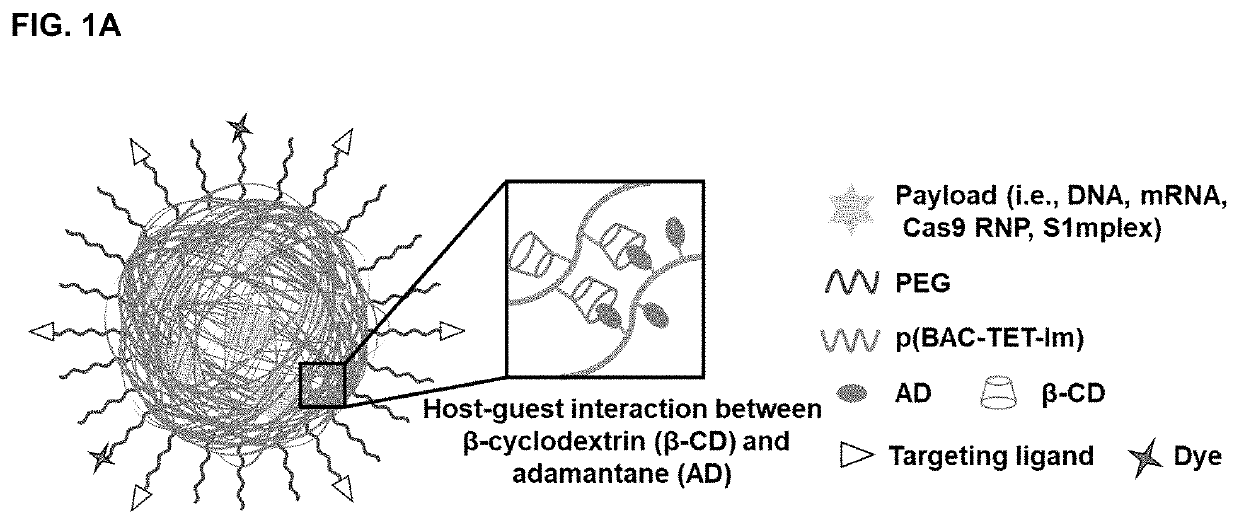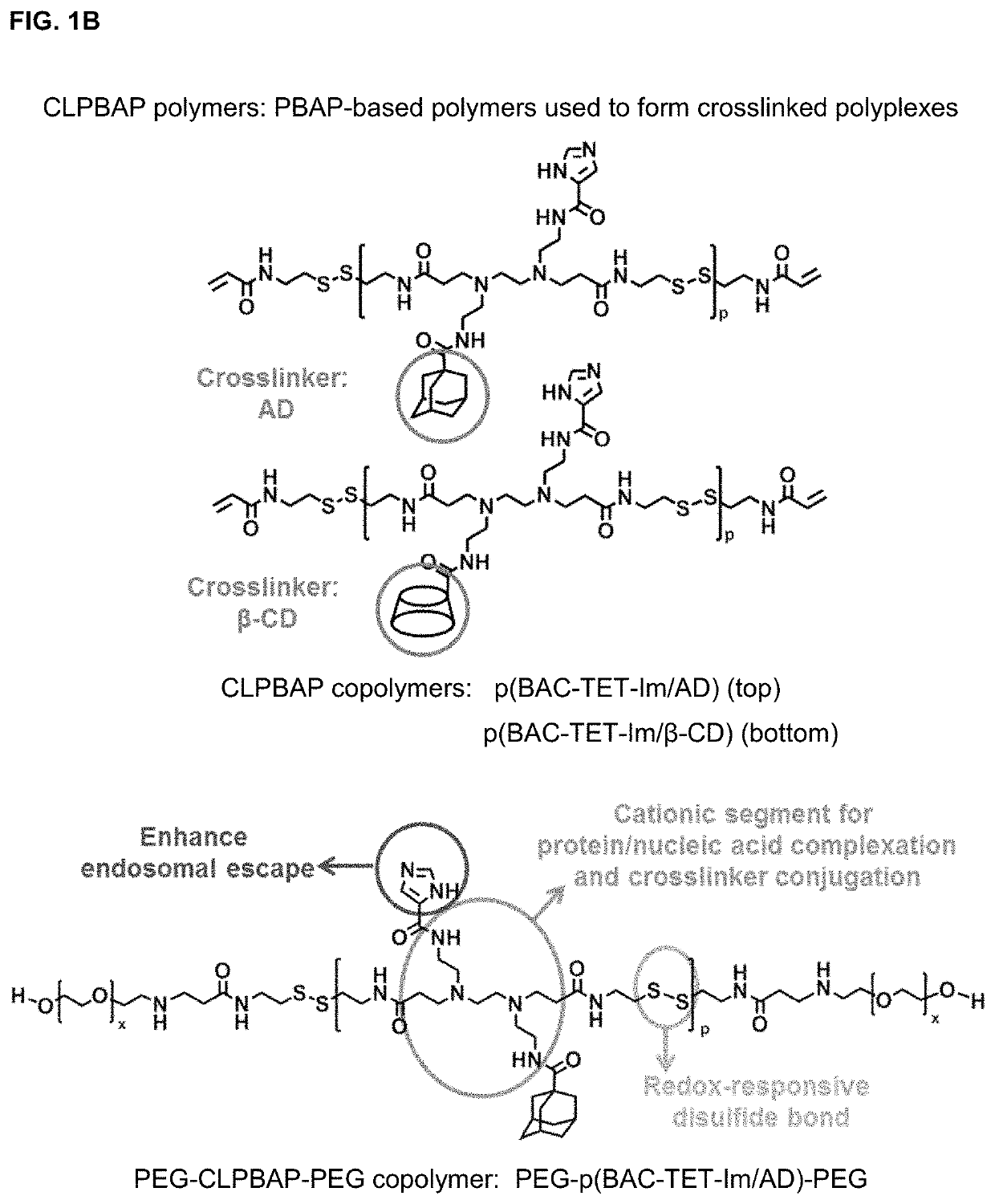Polyplex delivery system for proteins, nucleic acids and protein/nucleic acid complexes
a technology of nucleic acids and polyplexes, applied in the field of nanoplatform delivery systems, can solve problems such as endosomal-membrane disruption, and achieve the effect of facilitating endosomal escape of polyplexes
- Summary
- Abstract
- Description
- Claims
- Application Information
AI Technical Summary
Benefits of technology
Problems solved by technology
Method used
Image
Examples
example 1
on of Copolymers for Polyplex
Synthesis of N,N′-[1,2-ethanediylbis(imino-2,1-ethanediyl)]bis[2,2,2-trifluoroacetamide] (Compound 1)
[0110]Ethyl trifluoroacetate was used to protect the primary amines in TET. TET (219 mg, 1.5 mmol, 1 equiv.) and TEA (455 mg, 4.5 mmol, 3 equiv.) were dissolved in 30 ml of methanol. Ethyl trifluoroacetate (532 mg, 3.75 mmol, 2.5 equiv.) dissolved in 20 ml methanol was added dropwise to the mixture and stirred at 20° C. After 24 h, the solvent was evaporated, and the mixture was purified by silica gel flash chromatography using an eluent of 1:1 v / v ethyl acetate and methanol to yield the product as a white solid (406 mg, 80% yield). 1H NMR (400 MHz, DMSO-d6): δ 2.56 (s, 4H, CF3CONHCH2CH2NHCH2CH2NHCH2CH2NH—COCF3); δ 2.63 (t, 4H, CF3CONHCH2CH2NHCH2CH2NHCH2CH2NHCOCF3); δ 3.24 (t, 4H, CF3CONHCH2CH2NHCH2CH2NHCH2CH2NHCOCF3).
Synthesis of poly(N,N′-bis(acryloyl)cystamine-co-triethylenetetramine) (p(BAC-TET))
[0111]p(BAC-TET) was synthesized via a Michael addition ...
example 2
on of the Non-Crosslinked and Crosslinked Polyplexes with Various Nucleic Acids and CRISPR-Cas9 Genome Editing Machinery
[0115]Polymer / payload polyplexes at various weight ratios were prepared using a two-step method. To form the non-crosslinked PBAP polyplexes, a sodium acetate buffer (NaOAc, 25 mM, pH 5.5) solution of p(BAC-TET-Im) polymer (5 mg / ml) was added to a payload solution (0.5 mg / ml) with varying p(BAC-TET-Im)-to-payload weight ratios. Sodium acetate buffer (NaOAc, 25 mM, pH 5.5) was then added to adjust the payload concentration to 50 μg / ml. The mixture was vortexed for 15 s and incubated for 30 min at room temperature to form the primary polyplexes. Then a sodium acetate buffer (NaOAc, 25 mM, pH 5.5) solution of PEG-p(BAC-TET-Im)-PEG polymer (5 mg / ml) and sodium acetate buffer (NaOAc, 25 mM, pH 5.5) were added to the primary polyplex solution to keep the payload concentration at 25 μg / ml. The mixture was vortexed (15 s) and incubated (30 min) at room temperature to obtai...
example 3
Bioactivity in Delivering Polynucleic Acids and Protein Complexes with Polynucleic Acid
[0117]DNA Transfection Efficiency Study.
[0118]HEK 293 cells were seeded onto a 96 well plate at the amount of 20,000 per well 24 h prior to treatment. Cell culture media volume was 100 μl / well. Cells were transfected with green fluorescence protein (GFP) plasmid (Addgene, USA, 200 ng / well) using Lipofectamine™ 2000 (Lipo 2000, Thermo Fisher, USA) loaded with DNA, non-crosslinked PBAP polyplexes with different polymer / DNA weight ratios, and crosslinked CLPBAP polyplexes with different AD:β-CD molar ratio (4:2, 4:3, 4:4, 4:5 and 4:6). An untreated group was used as the control group. Cells were harvested with 0.25% trypsin (Thermo Fisher, USA) 24 h and 48 h post-treatment, spun down, and resuspended with 500 μl PBS (Thermo Fisher, USA). GFP expression efficiencies were obtained with an Attune NxT flow cytometer system (Thermo Fisher, USA) and analyzed with FlowJo 7.6.
[0119]To study the stability of ...
PUM
| Property | Measurement | Unit |
|---|---|---|
| pKa | aaaaa | aaaaa |
| hydrodynamic diameter | aaaaa | aaaaa |
| molecular weight | aaaaa | aaaaa |
Abstract
Description
Claims
Application Information
 Login to View More
Login to View More - R&D
- Intellectual Property
- Life Sciences
- Materials
- Tech Scout
- Unparalleled Data Quality
- Higher Quality Content
- 60% Fewer Hallucinations
Browse by: Latest US Patents, China's latest patents, Technical Efficacy Thesaurus, Application Domain, Technology Topic, Popular Technical Reports.
© 2025 PatSnap. All rights reserved.Legal|Privacy policy|Modern Slavery Act Transparency Statement|Sitemap|About US| Contact US: help@patsnap.com



